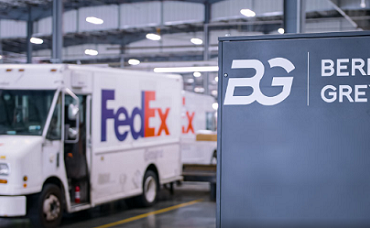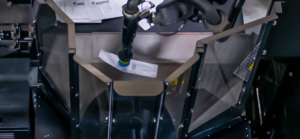FedEx Ground Turns to AI Robotic Arms to Sort Small Packages in Time for the Holiday Rush

For the first time, FedEx Ground is using AI-enabled robotic arms in some of its package sorting facilities to increase the number of tougher-to-handle small packages that can be sorted and routed every hour, while also allowing hard-to-find workers to focus on more important tasks.
The shipping company has been using two robotic arm systems from enterprise robotics vendor Berkshire Grey since March 2021 in its package sorting and delivery center in Queens, N.Y., and is planning to have two more systems in operation in its shipping hubs in Las Vegas and Columbus, Ohio, by later this year.
The Robotic Product Sortation and Identification (RPSi) systems from Berkshire Grey sort thousands of small packages as they arrive to the Queens facility each day and place them one by one into containers that are bound for other shipping hubs across the FedEx Ground network, according to FedEx. The smaller packages include individual plastic shipping bags, plastic tubes, padded mailers, and small boxes.
The robotic arm systems are needed to streamline the process for the increased number of smaller packages that have arrived at FedEx Ground facilities over the last 18 months due to the COVID-19 pandemic and the demands of more consumers and businesses buying products online, Ted Dengel, managing director of operations technology and innovation at FedEx Ground, told EnterpriseAI.
“In some of our largest facilities, we do have automated sortation systems, traditional material handling, that handles those smaller packages but that is a small handful,” perhaps 15 or 20 of the 550 to 600 package distribution facilities used by the company, said Dengel. “In every other place, it is a very manual process where the packages come in larger bins, and they are fed to a person. Then that person is manually sorting them in circular bins that are [positioned] around them.”
The packages are scanned and then the packages move on to their destination, with sorting reminiscent of an old-fashioned mail room.
“Because they are smaller packages, they can fit into what is roughly the size of a shoe box, maybe a little bit bigger,” for processing, said Dengel.
The conveyor then feeds it up to a robotic arm that is grabbing package by package and drops it through a specialized HyperScanner label reader from Berkshire Grey, he said. The HyperScanner reads the label images from any direction as the package is in the air, captures its barcode and then sends it off to its destination. A mechanical shuttle system takes the package and drops it into a bag, where it will be picked up by a human worker for shipping with other packages that are heading to the same place.
The coming FedEx Ground robotic arm systems in Las Vegas and Columbus, Ohio, are expected to be arriving just in time to handle what is expected to be a growing number of packages that will be processed during the upcoming winter holiday shopping season, said Dengel.
Berkshire Grey said the new RPSi systems were developed as a direct response to the exponential growth of e-commerce that took off due to the pandemic as well as related labor shortages which make it harder for companies to find enough workers to perform manual work.
The RPSi system being used in the FedEx Ground facility in Las Vegas has been in full production since March, said Dengel.
“E-commerce is driving a huge amount of those small packages,” he said, which are more complicated to handle than the larger boxes and packages that go through the company’s traditional package sorting systems.
The RPSi systems include one robotic arm per unit and with two systems deployed or planned for the first three FedEx Ground facilities, that means there will be two robotic arms to process package small packages in each of those facilities, he said.
“We are seeing the same productivity rates as we would see with a human – and maybe even a little bit faster – some 1,000 to 1,100 packages per hour,” said Dengel. “As we move people away from repetitive tasks like the manual sorting, we can move them into other positions. We are always striving to get workers in all the markets, and it is becoming more and more of a challenge. So, this is really about redeploying the people that are doing that manual work into other higher-level positions.”
FedEx Ground had been looking at using robotics for the last few years, he said, but the systems they saw did not meet their specific needs as a shipping company.

A Berkshire Grey robotic arm continues to process a package in the FedEx Ground facillity in Queens, N.Y.
“Given the variability that we have in our world robotics has not always been a good fit for the logistics market,” said Dengel. “It has been great in manufacturing, doing the same thing over and over and over, but advancements in the last few years with AI and camera-sensing and motion-sensing has really started making a play for it.”
FedEx Ground has always had success handling and automating standard-sized and larger boxes in its systems, but the smaller packages continued to be challenging until the company found Berkshire Grey’s products, he said.
“For pieces of this system, we worked with them to define what we needed,” he said. “It has really been a great partnership and allowed us to automate the [handling of the] smallest packages.”
FedEx Ground will continue to look at bringing similar RPSi systems into more of its shipping centers in the future, according to Dengel.
“We are still evaluating that,” he said. “We have roughly 550 to 600 facilities in total, but it would not apply to all of those. There will be a good chunk of them and that is the battle we are evaluating right now, where does it make sense in terms of volume and from a cost-benefit, where we were going to get the biggest bang for these. We care going to take the rest of this year and early next year to evaluate that and plan our process going forward.”
So far, they are a great fit, he said.
“Everybody is ordering from home, e-commerce has accelerated through the two years of the pandemic,” said Dengel. “We have more and more of these small packages we need to figure out how to handle with a tight labor market. This is a great solution that does it efficiently, accurately and safely. It ticks all the boxes for us.”
Shelly Kramer, principal analyst and co-founder of Futurum Research, told EnterpriseAI that bringing AI into enterprise systems like this one is exciting to watch.
“Package sorting is a perfect example of a routine, banal task but an important one,” said Kramer. “When AI/ML can be employed to streamline that kind of a process within an organization, everybody wins, including the customers, who end up – hopefully – getting whatever it is they need – in this case, their packages – in a timely manner.”
These uses of robotics and AI are already proliferating, she added.
“I was just talking with my teenagers the other day about robotics and AI and giving them an example of autonomous pizza delivery being used right now in some markets by Domino’s Pizza,” said Kramer. “When it comes to task automation, without question if it can be automated, it will be automated. And in many instances, it should be automated.”














